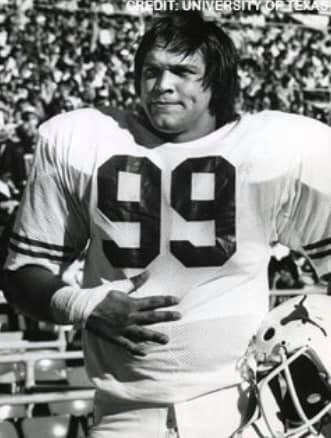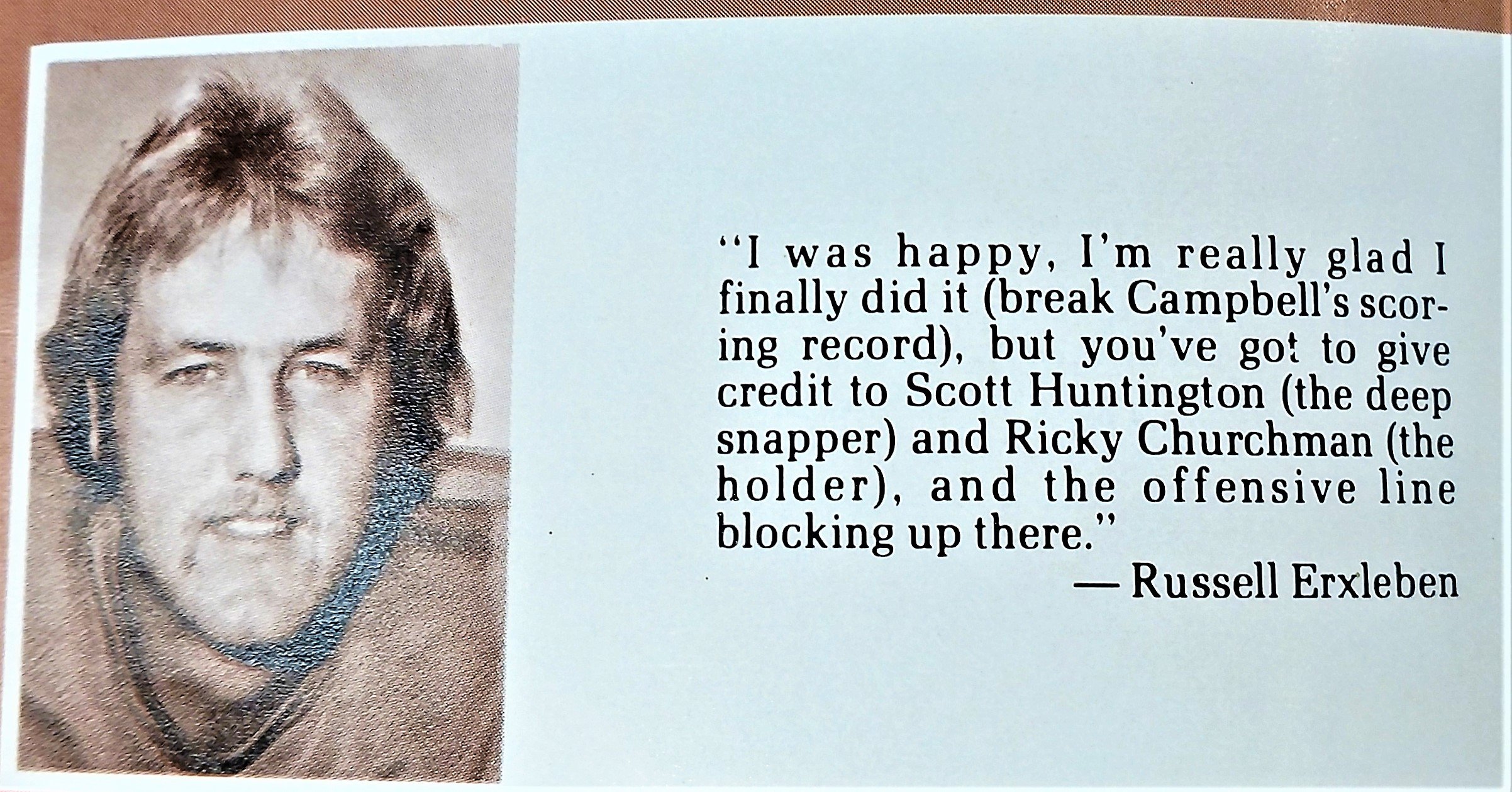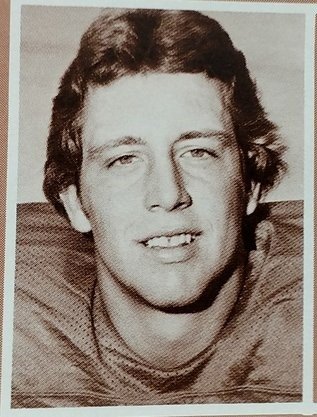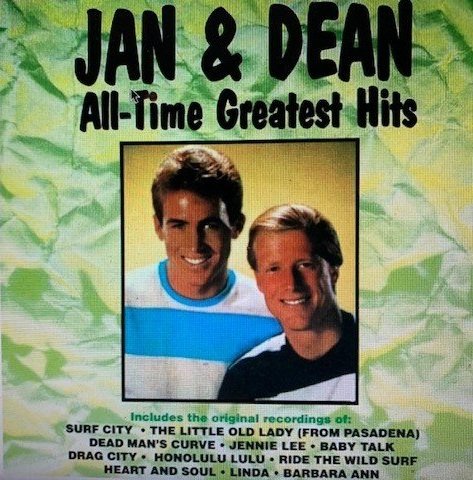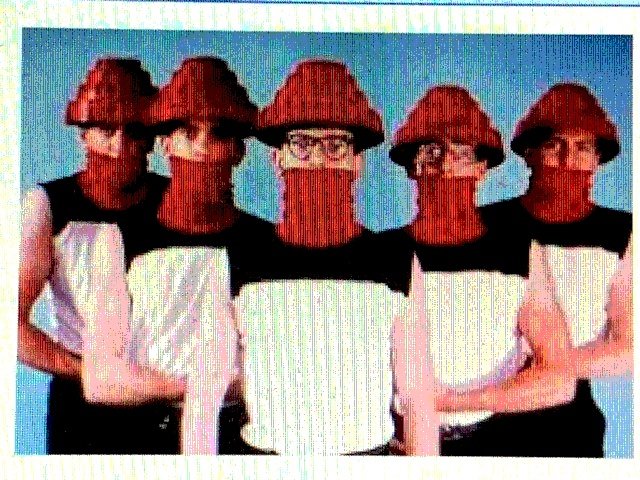AVOID YES/NO QUESTIONS, PLEASE
by Larry Carlson
Larry interviewing Coach Akers
I got my wife to proof this column and she made me scratch the lead and start over.
"Get to the point," she said.
Sage advice. Especially since this is about interviews, good and bad.
Once upon a time, I interviewed athletes every day. Now, thanks to TLSN, I still get to talk to fascinating people who wore the burnt orange. Sports interviews should be great fun and produce worthy responses.
Crisp interview questions get to the point.
Bad ones don't.
That in mind, prepare yourself this week. The biggest overload of cringe-worthy questions of the football season is teed up. We always save the worst for last. The Big Game With Roman Numerals.
More unqualified yet somehow credentialed interviewers than for any other sports contest are gathering now in Los Angeles.
The forecast calls for a heavier than usual dose of non-questions for Joe Burrow, Matthew Stafford and the guy who follows Sean McVay on the sideline, ready to apply more hair gel.
"Talk about the game," will be one particularly vague command.
Asking (or telling) anyone to "talk about....." is unforgivably lame. But it happens every day, for every sport, including politics.
It's like getting a one-on-one with the President and lasering in with, "Talk about the world."
Just a tad vague.
You're also going to get plenty of statements somehow intended to be a question.
"Joe Burrow can pass," some genius will utter into a microphone to a Ram defender.
Uh...yes. Yes, he can. But most interviewees will politely go with it when tossed a statement, and will respond with something politely vacuous such as, "Yeah, he's a threat on every play. We're gonna have to be ready."
Stats are another source of non-questions. "Three touchdowns, 322 yards...."
Not everyone in a sporting spotlight will be so gracious. Names like Gregg Popovich, Marshawn Lynch and Bobby Knight immediately come to mind.
I'm not going to defend the track records of the boorish aforementioned trio, but perhaps more coaches and players should be a little more demanding of solid questions from alleged experts, without getting surly.
I mean, is it really that tough to come up with something pertinent after a game?
Immediately hitting the winning coach with, "You've gotta be pleased..." isn't hard-hitting journalism or aimed at anything but a standard response. And maybe that coach -- with a cheating spouse and a kid who just got fitted with an ankle bracelet that day -- isn't really all that pleased, in spite of a "W.".
A question would work better, in most cases. And not a yes/no question. Watch your least favorite local sportscaster ask those queries to nervous high school football players next August, and savor the steady response of "Yezzir," "Yezzir" and occasionally a "Nozzir."
Lame questions happen in all settings. In a press conference
in the Zoom era, (now often referred to as a "media availability") five days before a game, on the sidelines prior to kickoff, at halftime and in post-game situations. Pre-game and in-game questioning is tough, though. What do you ask that hasn't been asked all week? Still, someone who collects paychecks as hefty as the ones Erin Andrews lands, should be ready for tastier food for thought than what she gave Matthew Stafford in the immediate wake of LA's win over San Francisco. It was something like, "You said it couldn't happen and now you're here....." Fortunately, one of Stafford's teammates ran by, hugged him and de-railed the "question."
The Austin radio station I was employed by in the early Fred Akers era had a paid arrangement for UT's coach to answer a few of my questions each game, right before kickoff. I loved hosting the expansive post-game locker room show with players and coaches. Loved it. But I didn't like the very brief pre-game deal because Akers was wound so tightly at those times. Coach didn't like it, either. Because he was wound so tightly at those times. Not a good formula.
I still recall one instance in which, because of a lingering injury, a key Longhorn player's availability had been called "a gametime decision" all week. So, two minutes before the opening whistle, chesty young sportscaster that I was, I saved that topic for the last of my three pre-game questions that Coach was being paid for. "All week long, it's been a hot topic....is (John Doe Player) gonna play?" I asked.
"Well, we're gonna put eleven out there," Fred said, tersely.
Right. Was expecting same, as standout detective and expert interviewer Charlie Chan was apt to say.
Too many broadcast interviewers want to impress the audience and the interviewee and get technical or launch the fifty-dollar words that nobody uses in conversation. The greats like Howard Cosell, Roy Firestone and Bob Costas have all been guilty. And plenty of guys in weekly "media availabilities" wish to show off "insider" terminology. They waste time and trigger winces from cohorts when they ask coaches if the new lineman recruit has flexible enough hips. Or if the Horns were in the dollar package on the first series.
It was hardly the lone gaffe I made, but I still wonder -- after four decades -- why I asked a player "Just what are your dimensions?" He was an undersized but aggressive guy who replaced a standout and acquitted himself well. His slight frame was notable, so I thought it worthwhile to nail down the specifics. But it was live radio and as a freshman and backup, he had not faced interviews before. So after citing the fact that he was not quite the expected size for his position, I asked him to provide us with those "dimensions."
He suddenly looked terrified, went blank and finally stammered something about just playing hard.
I said, "How big are ya?" That clarified things. He wasn't a dim bulb; my choice of words was stupid.
It taught me one thing to later emphasize to my broadcast students at Southwest Texas/Texas State. Don't use words in conversation that are meant for print. Don't call a fire a conflagration or blaze, don't say somebody was incarcerated when they went to jail. Keep it simple.
One other thing I learned early on, and later told my young would-be interviewers to do was -- whenever possible -- lean on the brightest players for live interviews. Covering UT had made that easy for me. Plenty of smart guys.
Future judges Jim Yarbrough and Dwight Jefferson were clear, crisp and insightful.
Future NFL star and wrestler Steve McMichael was funny, blunt and bawdy. All-America punter/kicker Russell Erxleben would talk about anything, and didn't mind needling an opponent. Linebackers Lance Taylor and Morgan Copeland were always friendly, interesting and analytical.
One particular encounter with Morgan is etched in my brain files. On the live, post-game Longhorn Locker Room show, I referenced something that happened on the sidelines during the game. Said Morgan, "I wasn't cognizant of that."
First and last time, thus far, that anybody utilized that word when I was interviewing them. Made me smile. And it fit. I could've likely asked Morgan to explain the difference between nuclear fission and fusion, though I would have certainly been lost.
When Morgan Copeland wasn't working hard as a captain and a beast on the field, he was earning academic awards. He was a National Football Foundation (NFF) National Scholar-Athlete award winner and graduated with honors before taking on UT Law School. Copeland has been a successful attorney back in his hometown of Houston for many years.
Ahh, the art of the interview is, after all, a two-way street. No matter the preparation by the interviewer, the interviewee -- be he a player, coach, politician or celebrity -- has to also bring something to the table. Alas, not many interviewees come from the colorful school of Darrell Royal, Charles Barkley and Mike Leach.
So remember as you hear softballs lofted and hardballs fired at Rams and Bengals for a whole week, the interviewers should spare us the lazy "Talk about...." nonsense. And save the yes/no questions for the offbeat chance that OJ Simpson shows up at the party and can be asked if he did it. Yes, there is a time and place for short-answer questions. Did the Aggies just buy this recruiting class, Jimbo?
Some of the best and worst questions will come, not in the huge sessions with stars, when only ten of two thousand reporters will get a question in, but when somebody grabs the backup long snapper or emergency punter for a few questions. That's when the fun is had. Time to bust out the ol' BabaWawa Walters classic, "If you were a twee, what kind of a twee would you be?"
So what would you conjure up as compelling? thought-provoking query for a player at The Big Game With Roman Numerals? I've got mine ready. How can Devo get nominated for the Rock and Roll Hall of Fame when Jan & Dean still aren't in? Inquiring minds want to know.
TLSN TLSN TLSN TLSN TLSN
Longhorn Football Factories
by Larry Carlson texaslsn.org
Ever wonder which cities, which high schools have produced the most Longhorn footballers of note over the years? I have. Growing up on Texas football as a kid in the '60s, I pored over the game programs, memorized the 3-deep roster in Dave Campbell's Texas Football and listened intently as lords of the radio such as Kern Tips regularly provided shoutouts to hometowns of heroes in burnt orange.
One small Texas town, Cleburne, stood out for producing Longhorn stalwarts in the Darrell Royal regime.
Five former Yellow Jackets starred for Royal. Fiery LB Pat Culpepper was All-Southwest Conference in '62, David McWilliams stood out as a center and LB for the '63 national champs and served UT as head coach from 1987-91, leading Texas to the SWC title. Another linebacker, Tim Doerr, was a key contributor for the '63 champs and helped Tommy Nobis anchor the '64 defense that won the Orange Bowl. Howard Goad was an all-SWC guard in '66 and DB Fred Sarchet was a key defender for Royal's '75 team that shared the SWC crown. Remarkably, all but Goad were captains for the Longhorns.
If there's another town with a single high school that can top Cleburne as perhaps the biggest burnt orange football factory, it's Texas City. The Stingarees have cranked out Longhorns like Texas City produces petrochemicals. It started early in the Royal years, with tackles Eddie Padgett and All-American Don Talbert, followed by talented guard Marvin Kubin and versatile end Charlie Talbert, the second of the fearsome Talbert boys. He was a key player on both sides of the ball for UT's first national titlist in '63.
Clayton Lacy was another Texas City rock on that title team, and then came the "baby" of the Talbert clan, Diron. He was a '66 coverboy for Texas Football magazine and had an illustrious NFL career, first with the Rams, then the Redskins. It was more than three decades before Texas City again cranked up the football factory with a pipeline to Austin. Mack Brown's first signing class in '98 featured "the Texas City four," Everick Rawls, Tyrone Jones, Ervis Hill and Jermain Anderson. The quartet had led the Stings to a state title, and each one made his mark as a starter while on the Forty Acres. The most decorated Texas City hero is D'Onta Foreman, Doak Walker Award winner as the nation's top running back in 2016. Foreman rambled for more than 2000 yards in his final season at UT and averaged 6.4 yards a carry for Charlie Strong's three teams, before heading to a successful NFL career that is still churning.
A couple of other interesting factoids are out there. San Antonio's Jefferson High rolled out four notable players on the '63 national champs. Tommy Nobis was just a soph, and already a star. Wingback Phil Harris, a fellow soph, caught two touchdown passes (58 and 63 yards) from Duke Carlisle that sank Navy in the Cotton Bowl of 1-1-64. Hix Green and Anthony King were two more talented two-way backs and played big roles in the Horns' success from 1962-64.
Many Longhorn fans know that Earl Campbell played at Texas along with his twin brothers. Tim was a pass-rushing fiend at DE and Steve was a feisty, undersized linebacker, all from John Tyler High back home in the Rose Capital of Texas. Three brothers at Texas is remarkable anyway, any time, but the story of the Thurman boys is even more unusual. They hailed from White Deer, a tiny town of 1,000 souls, about 35 miles northeast of Amarillo in the Panhandle. Rick, Ken and Donnie were stairstep brothers (senior, junior and soph) for the '75 Longhorns. Rick was a starter at offensive tackle and earned three letters.
_________
Below, is a listing of some of the Lone Star State's most prolific producers of key Longhorn players from the DKR Era to the present. Keep in mind, though, there's nothing scientific about this. I just combed my mind and looked through some UT rosters from 1960 on. Many of the "old reliables" that Texas leaned on in, say, the '60s and '70s, have "dried up" as blue-chip breeding grounds. Some of the schools have closed.
And the state has grown exponentially, especially in the Houston and DFW metro areas. I'm bound to be missing several schools that have greatly benefitted the Longhorn football program. Keep in mind, though, that I didn't just count lettermen. I tried to go with players who were starters, made sizable on-field contributions, etc. So make your own list if you wish.
Here's my chart of some of the high school football programs that caught my eye, along with key players and their last season at Texas.
AUSTIN WESTLAKE: DT Brad Shearer ('77), OG Rick Ingraham ('77), K Jeff Ward ('86), LB Duane Duncum ('89), QB/S Jimmy Saxton ('91), WR Ryan Nunez '99), K Justin Tucker ('11), QB Sam Ehlinger ('20) Note: Current players include DB Michael Taaffe and edge pass-rushers Ethan Burke and Colton Vasek.
HOUSTON LAMAR: FB Ray Poage ('62), LB Corby Robertson ('68), DB Rod Babers ('02), DB Drew Kelson ('04), Brian Orakpo ('08), DB Holton Hill ('17), DB D'Shawn Jamison ('21)
PORT ARTHUR JEFFERSON/MEMORIAL: (Note: It's been called Port Arthur, Port Arthur Jefferson...and it merged into Memorial High in 2002...the flagship school of Port Arthur has pumped out Texas blue-chippers including several All-Americans. It's worth noting, too, that Dallas Super Bowl Coach Jimmy Johnson and Rock'n'Roll Hall of Famer and former UT student Janis Joplin, are also grads.)
C Clarence Bray ('63), T Clayton Lacy ('64), SE Cotton Speyrer ('70), DB Terry Melancon ('74), C Billy Gordon ('76), QB Todd Dodge ('85), WR Brent Duhon ('85), RB Jamaal Charles ('07)
SPRING BRANCH HIGH: C Jack Howe ('65), RB Chris Gilbert ('68), C Jim Achillles ('70), QB Donnie Wigginton ('71), C Bill Wyman ('73), RB Mike Luck ('83)
SPRING BRANCH MEMORIAL: WR Les Koenning ('80), DE Kiki DeAyala ('82), OG Doug Dawson ('83), C Gene "Coke Machine" Chilton ('85), QB Shannon Kelley ('88)
TYLER JOHN TYLER: RB Earl Campbell ('77), DE Tim Campbell ('78), LB Steve Campbell ('78), DB Joey Ellis ('94), DE Tim Crowder ('06), DB Aaron Ross ('06), DB Kitan Crawford ('23)
ODESSA PERMIAN: LB Glen Halsell ('69), RB Billy Dale ('70), Joe Bob Bizzell ('73), LB Britt Hager ('88), WR Roy Williams ('03)
TLSN TLSN TLSN TLSN TLSN




